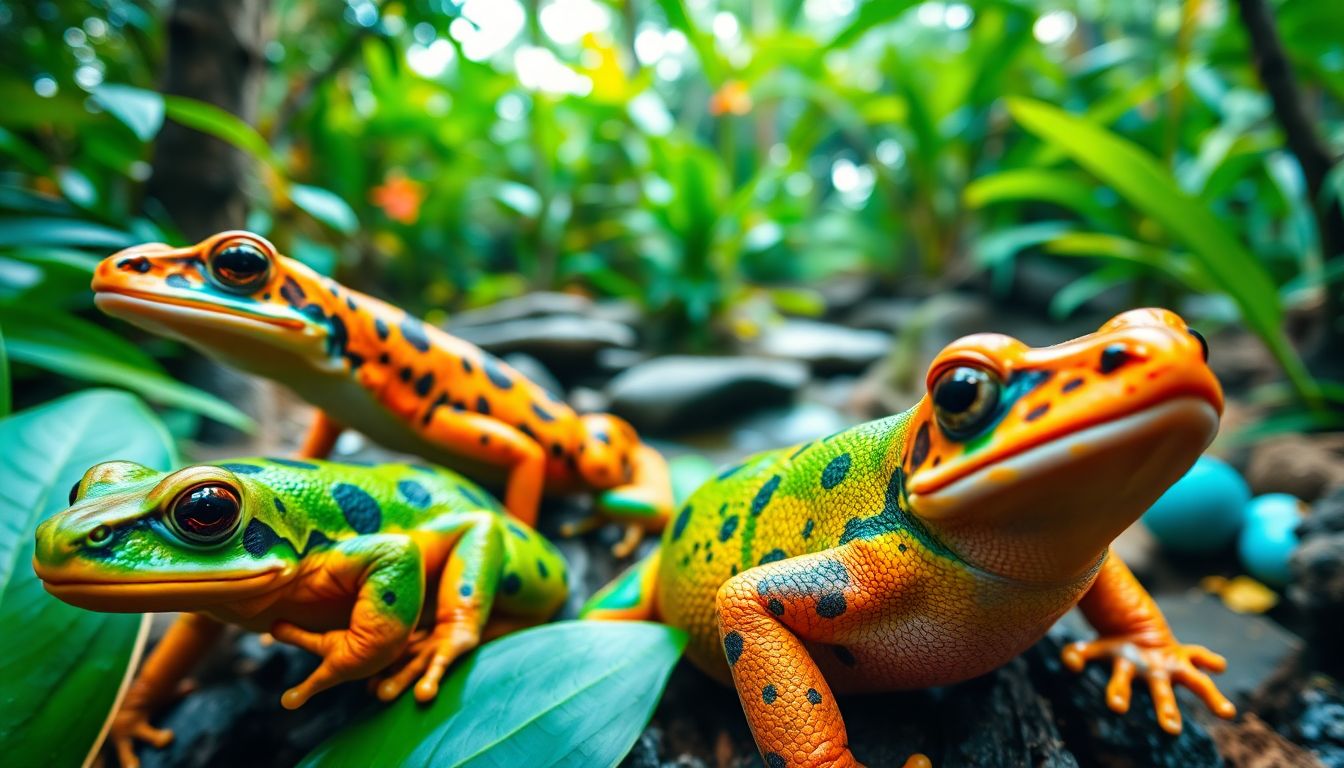 |
| Frogs |
Did you know that amphibians are disappearing at an alarming rate? Yet, they're some of the most adaptable creatures around. The amphibian world is full of surprises. Its biodiversity is something we should all care about. Get ready to meet some truly amazing amphibians. We're talking bright colors, crazy adaptations, and incredible survival stories.
Poison Dart Frogs: Tiny Jewels of the Rainforest
Imagine a frog so bright, it warns you to stay away. That's a poison dart frog for you! These tiny amphibians flaunt vibrant colors. They use this to signal their toxicity to potential predators. These hues aren't just for show; they're a matter of survival.
Aposematism: The Science Behind the Colors
Aposematism, or warning coloration, is a strategy used by many animals. It tells predators: "I'm dangerous, don't eat me!" Poison dart frogs do this really well. Their skin secretes toxins. For instance, batrachotoxin can cause paralysis and even death. Predators quickly learn to associate bright colors with danger.
Conservation Status and Threats
Sadly, these colorful frogs face serious threats. Habitat loss is a major problem. Climate change messes with their sensitive ecosystems. The pet trade also takes a toll. The golden poison frog is critically endangered because of its limited habitat. We need to protect these amazing creatures.
Where to Find These Dazzling Frogs
These frogs are found in Central and South America. They thrive in humid rainforests. You might spot the strawberry poison dart frog in Panama. Or perhaps, the blue poison dart frog in Suriname. Look closely, but don't touch!
Axolotls: The Eternal Children of the Amphibian World
Meet the axolotl, an amphibian that never grows up. They keep their larval features for life. This is called neoteny, and it's just one of the many things that makes them special. They also have amazing regenerative abilities.
Neoteny: Staying Young Forever
Neoteny is when an animal retains its juvenile traits as an adult. Axolotls keep their gills and fin-like tails. They can still reproduce. Scientists are studying the genes involved in neoteny. This may unlock secrets about development and aging.
Regeneration: Healing Powers
Axolotls can regrow limbs, spinal cords, and even parts of their brains. How cool is that? Scientists are investigating the cellular mechanisms behind this. It could lead to new treatments for injuries in humans. Imagine being able to regrow a limb!
The Axolotl as a Pet: Care and Considerations
Axolotls can be kept as pets, but they need special care. You'll need a tank with cool, clean water. Feed them a diet of worms and insects. Watch out for common health issues like fungal infections. Remember, responsible ownership is key.
Glass Frogs: See-Through Wonders
Ever seen a frog with transparent skin? Glass frogs are a sight to behold. Their see-through skin allows you to see their internal organs. It is an amazing adaptation.
Camouflage and Transparency
Their transparency helps them blend into their rainforest environment. It makes it harder for predators to spot them. The science behind their transparency is still being studied. Scientists believe it has to do with the way their skin cells scatter light.
Parental Care: Guarding the Eggs
Male glass frogs often guard their eggs. They protect them from predators and keep them hydrated. It's a tough job, but someone has to do it. This shows a strong commitment to their offspring's survival.
Habitat and Conservation Challenges
Glass frogs live in rainforests in Central and South America. They face threats from deforestation and pollution. Protecting their habitat is crucial for their survival. These unique amphibians need our help.
Caecilians: The Limbless Amphibians
These are the lesser-known amphibians. Caecilians look like snakes or worms. They lack limbs. They're adapted for a life underground.
Sensory Adaptations for a Life Underground
Living underground requires unique adaptations. Caecilians have sensory tentacles on their heads. These help them navigate and find prey in the dark. Their eyes are often reduced.
Reproduction and Parental Care
Caecilians have diverse reproductive strategies. Some lay eggs, while others give birth to live young. Some caecilians exhibit parental care. The mother nourishes her young with specialized skin cells.
Caecilians in Culture and Myth
In some cultures, caecilians are associated with fertility and good luck. They may appear in local folklore. People may see them as symbols of the earth. Despite this, they remain relatively unknown.
Conclusion
Amphibians are incredibly diverse and unique. They are vital to our planet's ecosystems. We must protect these amazing creatures. Learn more about amphibian conservation. Support organizations working to save them. Every action, no matter how small, makes a difference.











0 Comments